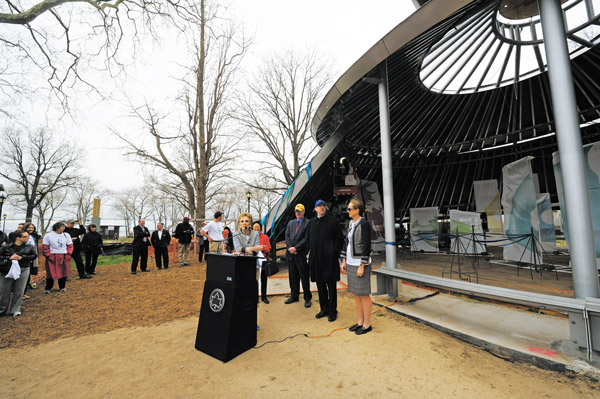
Battery Park’s high-tech SeaGlass carousel, which is opening in the fall, was topped off April 18.
BY TERESE LOEB KREUZER | The SeaGlass carousel in historic Battery Park at the southern end of Manhattan isn’t scheduled to open until the fall, but after what Superstorm Sandy did to Lower Manhattan, a celebration seemed in order on April 18 for the topping off of the structure’s shell.
“We need every step of the way to celebrate Downtown,” said Warrie Price, president of The Battery Conservancy, an organization that she founded in 1994 to help rehabilitate the 25-acre Battery Park.
The conservancy raised $16 million to design, build and landscape the carousel, which will feature 30 fiberglass fish, each more than nine feet tall, and a programmable sound and light show.
The carousel’s foundation “was bone dry during Sandy,” Price said, but much of the park experienced the full force of Superstorm Sandy. The storm destroyed the wiring for the intricately programmed Bosque fountain and leveled five mature trees, including the park’s last remaining American elm — which took the playground equipment down with it.
The New Amsterdam pavilion in Peter Minuit Plaza has not yet reopened. In addition, the storm flooded the conservancy’s office at 1 New York Plaza. The office has since relocated to 1 Whitehall St.
The park’s gardens were submerged under salt water for hours. In the aftermath, the conservancy consulted the New Orleans Botanical Garden, which experienced similar problems after Hurricane Katrina.
“We followed their advice to flush out the gardens and to add nutrient-rich soil,” said Hope Cohen, the conservancy’s chief administration and finance officer. “When Sandy struck, we had recently turned off the irrigation system for the season. We turned it back on so we could flush the gardens and we cut back all the damaged plant material. We’re now watching, fingers crossed. Our horticulturists are encouraged but we won’t really know that for a couple more weeks.”
Amidst this swath of destruction, the carousel stands like a beacon. The spiral-shaped pavilion of glass and steel, designed by WXY Architecture, looks a chambered nautilus. The walls will change color from transparent to cobalt blue, simulating a descent into the sea. Riders will sit on iridescent fish designed by the George Tsypin Opera Factory and built by in Montreal by Show Canada, whose clients include Cirque du Soleil.
They will be arriving in Battery Park over the course of the summer.
“We use the word ‘carousel’ because it is in a park and you ride figures in a circle and they go up and down,” said Cohen, “but beyond that, it’s not like any carousel that any of us has ever experienced. It will be like going to the planetarium, except that you get to ride. It will be like going to another world.”
The carousel is being built with a combination of public and private funds. The City Council contributed $1 million; the mayor, $3 million; the Lower Manhattan Development Corporation, $2.7 million; and $750,000 came from Manhattan Borough President Scott Stringer’s office. The conservancy also used some of its reserve.
Each fish costs $100,000 to sponsor, and 20 of the 30 fish so far have sponsors.
Renowned Dutch landscape architect Piet Oudolf has designed plantings for the acre surrounding the carousel, funded by a donation of $1 million from the Tiffany & Co. Foundation.
Fees to ride the carousel have not been set but they will go toward its maintenance.
The carousel is only one of several construction projects currently under way in the park. The Parks Department is building a bikeway on the perimeter. This means that the hugely popular and successful Urban Farm will have to be moved, but it will definitely continue. Students from 11 schools raised crops there in 2012.
The Sphere, which once stood on the plaza of the World Trade Center, will also have to be moved from its current location on Battery Park’s Town Green. The eternal flame has already been moved to a location near the Korean War monument on the park’s northwestern flank.
The Battery Conservancy has spent the winter and nearly $100,000 of its own money to repair the wiring and controls of the Bosque fountain. Valves have been installed on all of its pipes so that it can be quickly shut down in an emergency. A form-fitting umbrella has been created to shelter the vault where the controls are housed.
“We expect to be able to turn the fountain on this spring,” said Cohen.
She is optimistic that these preparations will be sufficient protection against future storms.
“Sandy was a unique convergence of meteorological events,” she said. “We should not see a surge like that again any time soon. We will have storms, we do have climate change, we will see sea level rise — but the particular circumstances of Sandy were a convergence of something like four different events that multiplied the effect, and that convergence is pretty rare. We think that Sandy is as bad as we’re going to see in our lifetimes in this spot.”

















